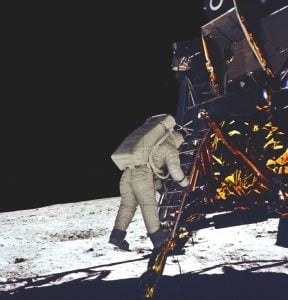Landing on the moon – Planning and designing a lunar lander
In this set of activities, students will plan, design and build a landing module to secure the survival of the crew (in the form of an egg-naut) landing on the Moon.
They will explore which factors should be considered when landing on the Moon, in comparison to landing on Earth.
In the design of the lunar lander, students must take risk factors and budgeting into account.
Learning Objectives
Age range:
14 – 16 years old
Time
Preparation: 1 hour
Lesson: 2 hours and 30 minutes
Lesson: 2 hours and 30 minutes
Resource available in:
Activity 1: Design and build a lunar landing module
In this activity, students will design and build a lunar landing module using simple materials. The objective is to design a lander that can safely land an egg-naut on the surface of the Moon. In their planning, students must consider the risks involved in a manned lunar lander mission and perform a risk assessment and a design study.

Equipment
Activity 2: Test your landing module
In this activity, students will test if their landers survive a vertical drop, keeping the egg-naut safe. They will describe the landing conditions and keep track of other factors that can influence the results. Optionally, students can film the drop and later use a video analysing tool to examine the acceleration.
Equipment
Activity 3: Landing on the Moon
In this activity, students will compare landing on Earth with landing on the Moon. They will investigate the different factors influencing the landing in both locations and the forces diagram. Further, the students will re-iterate the design of their lander on what they have learned during the testing.
Equipment
Did you know?
The total cost of the Apollo space programme that took humans to the Moon was $25.4 billion – that is more than $200 billion in today’s currency, adjusted for inflation. In 2018, ESA’s total budget was 5.6 billion Euros.
Currently, space agencies and industry are working together to develop a more sustainable Moon exploration program. It should be noted that today we will still use part of the infrastructure created in the 1960s: test chambers, launch pads, mission control centres, ground stations, engineering knowledge, technology, materials and thus a lunar exploration program will be much more sustainable from the beginning.
Currently, space agencies and industry are working together to develop a more sustainable Moon exploration program. It should be noted that today we will still use part of the infrastructure created in the 1960s: test chambers, launch pads, mission control centres, ground stations, engineering knowledge, technology, materials and thus a lunar exploration program will be much more sustainable from the beginning.

Buzz Aldrin at work at the Eagle landing module on the Moon
Keywords:

Moon Rover – Building a solar powered rover
Brief description: In this activity, students will compare the advantages and disadvantages of renewable energy sources and non-renewable energy sources and study simple electrical circuits.

Bionic Hand – Building a bionic hand
Brief description: In this activity, pupils will build a bionic hand made out of cardboard, strings, straws and rubber bands. They will relate the bionic

Mission on the Moon – Program a classmate to complete a mission on the Moon
Brief description: This activity will introduce students to logical thinking by planning, testing and executing a simple mission on the Moon. Students will work in



